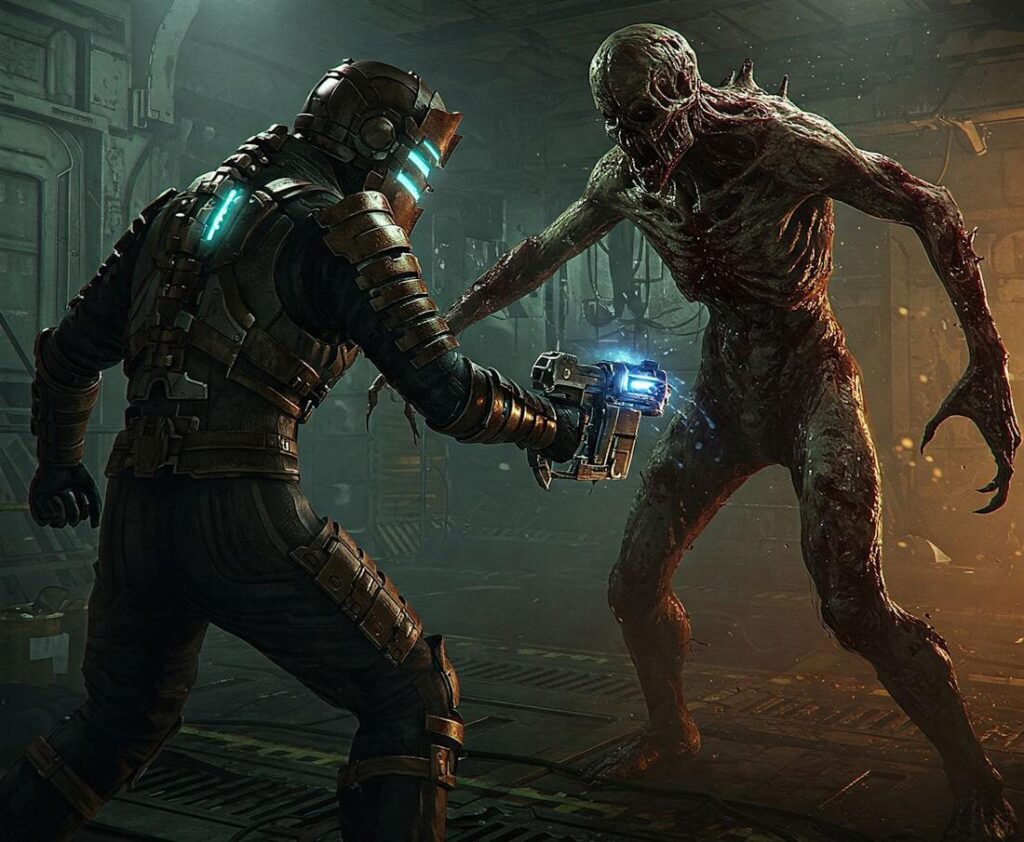‘Dead Space Remake’ is a contemporary reimagining of the original 2008 survival horror game developed by EA Motive. The remake has generated considerable anticipation within the gaming community due to its promise to enhance the original experience while remaining faithful to the core elements that defined the initial offering. This revival aims not only to rekindle nostalgic sentiments among longtime fans but also to engage a new generation of players eager to delve into the unnerving universe of the ‘Dead Space’ franchise.
The significance of ‘Dead Space Remake’ in the gaming industry cannot be understated. In recent years, the trend of remaking classic titles has surged, providing opportunities for developers to leverage advancements in technology to elevate gameplay, graphics, and storytelling. ‘Dead Space Remake’ exemplifies this trend by utilizing modern engines and techniques, resulting in striking visuals and immersive sound design that enhance the terrifying atmosphere. The developers have also made substantial improvements in gameplay mechanics, ensuring a responsive and fluid user experience that complements the horror elements of the narrative.
Furthermore, the narrative in ‘Dead Space Remake’ has been refined to provide more depth and context to the characters and events. By integrating new storytelling techniques, the remake allows players to experience a more immersive journey filled with psychological tension and dread. These developments signify a commitment to not only preserve the essence of the original title but also to innovate and evolve within the horror genre. As we progress through this exploration, it will be vital to assess how these advancements contribute to the overarching themes of fear and survival that are intrinsic to the ‘Dead Space’ legacy.
Understanding Classic Horror Elements
Classic horror, a genre that has captivated audiences for centuries, is characterized by several foundational elements that evoke dread and invoke fear. Key themes such as isolation, the fear of the unknown, psychological terror, and suspense are paramount in establishing an atmosphere where fear thrives. These essential elements not only serve to create chilling narratives but also connect deeply with human fears and anxieties.
Isolation is a prevalent theme in many classic horror films and literature, effectively heightening the sense of vulnerability and entrapment. A prime example can be found in films like “The Shining,” where the remote setting of the Overlook Hotel intensifies the protagonist’s descent into madness. This theme is mirrored in many literary works as well, such as Mary Shelley’s “Frankenstein,” where characters often grapple with their solitude amidst terrifying circumstances.
The fear of the unknown is another crucial element that drives the genre. This notion encapsulates the anxiety that arises from encountering entities or forces beyond comprehension. The closing scenes of classics like “Alfred Hitchcock’s Psycho” demonstrate how leaving certain aspects to the imagination can amplify fear. By not fully revealing the monster or threat, audiences are left in suspense, a technique that results in heightened tension and anxiety.
Psychological terror manifests through the characters’ inner struggles and conflicts, drawing viewers into a realm where the true terror lies within. Works such as Edgar Allan Poe’s short stories exemplify how psychological horror can leave an indelible mark on the audience, blurring the line between reality and insanity. Elements of suspense, whether through music, pacing, or visual cues, play a vital role in maintaining tension and engaging the audience’s senses, thereby enhancing the overall experience of horror.
Atmospheric Design and Setting
The ‘Dead Space Remake’ ingeniously employs atmospheric design to elicit a profound sense of dread and claustrophobia, essential elements in the realm of horror gaming. The environments are meticulously crafted to reflect the desolation of the USG Ishimura, a mining ship that is transformed into a chilling and haunting space. Each corridor, room, and interface effectively communicates a haunting narrative, amplifying the player’s anxiety as they traverse the unsettling spaces. The intricate details embedded in the visuals—such as flickering lights, ominous shadows, and the signs of previous struggles—contribute substantially to the immersive experience, making players feel as though they are physically within this horrifying world.
Lighting plays a crucial role in the atmospheric design of ‘Dead Space Remake’. The use of dynamic lighting not only establishes a sense of realism but also evokes tension. Areas illuminated only by emergency lights create an unpredictability, preventing players from feeling secure, while deep shadows conceal lurking threats that heighten the constant state of fear. This strategic use of light and dark serves to distort the spatial perception, allowing for moments of surprise that are integral to maintaining the horror essence. As players navigate the ship, they are frequently reminded of the oppressive confines, where every corner could hide a lurking danger or an unspeakable horror.
Sound design further intensifies the game’s atmosphere, as it artistically weaves an audio tapestry that complements the visual elements. The haunting score, combined with the unsettling noises of machinery and distant, unnerving sounds, creates an overwhelming sense of isolation. This auditory backdrop ensures that players are continually aware of potential threats, even in moments of relative quiet, fostering an environment thick with tension and anticipation. Together, the environmental design, lighting, and sound work in harmony, encapsulating the core essence of horror gaming and drawing players into the chilling universe of the ‘Dead Space Remake’.
Character Development and Psychological Horror
The ‘Dead Space Remake’ significantly emphasizes character development, intertwining it with the essence of psychological horror. At the forefront is Isaac Clarke, the game’s protagonist, whose journey is emblematic of classic horror archetypes. Initially introduced as an ordinary engineer, Isaac confronts a terrifying extraterrestrial threat aboard the USG Ishimura, which catalyzes his transformation into a reluctant hero. This evolution parallels the traditional horror narrative, wherein an unsuspecting figure faces insurmountable odds, triggering a profound character arc that illustrates themes of fear and survival.
As the story unfolds, the psychological horror elements intensify, with Isaac’s experiences exposing him to deep-seated anxiety and moral ambiguity. Faced with the grotesque manifestations of the Necromorphs, his mental state deteriorates, illustrating the torment of encountering unfathomable horrors. The game delves into the intricacies of Isaac’s psyche, drawing players into his turbulent emotional landscape marked by confounding guilt and desperation. This exploration of mental fragility provides a sophisticated layer to the horror narrative, revealing that the most chilling aspects lie not only in external threats but also within the human mind.
Furthermore, the backstories of supporting characters play a vital role in expanding the horror narrative of the remake. For instance, Nicole, Isaac’s love interest, is depicted through fragmented communications, adding depth to both her character and the overall tension. Each character’s motivations and struggles contribute to the ambient dread, effectively showcasing how fear can stem from human relationships and the resulting psychological ramifications. This multifaceted approach toward character development not only enhances the emotional stakes but also amplifies the overall horror experience, making the ‘Dead Space Remake’ a profound exploration of psychological horror.
Innovative Gameplay Mechanics
The gameplay mechanics of ‘Dead Space Remake’ are a vital component in amplifying the horror experience. By integrating limited resources and strategic weapon usage, the remake successfully enhances the suspense and tension that define the game. Players navigate through the treacherous environments of the Ishimura spacecraft, where every encounter with the terrifying Necromorphs forces them to make critical decisions. The scarcity of ammunition and health packs instills a sense of dread, compelling players to think strategically about how to confront or evade their enemies.
Moreover, the environmental storytelling in ‘Dead Space Remake’ further immerses players in the horrific atmosphere. Each room and corridor is designed with meticulous detail, revealing snippets of the disastrous events that befell the crew, which fosters a deeper emotional connection to the setting. Players uncover audio logs, text entries, and visual cues that weave together a narrative of despair and horror, enhancing the overall gameplay experience while echoing themes found in classic horror storytelling.
In terms of innovative features, ‘Dead Space Remake’ introduces enhancements such as improved visuals and sound design, which create a more visceral experience. The game’s graphical fidelity allows for realistic lighting and shadow effects that transform the game’s environments, making them feel alive and menacing. The redesigned soundscape plays a crucial role; the unsettling audio cues heighten the player’s anxiety and anticipation, ensuring that each encounter with the Necromorphs feels unpredictable and terrifying.
Overall, the combination of these gameplay mechanics not only mirrors the elements of classic horror but also elevates them, ensuring that both new and returning players experience the intense fear that ‘Dead Space’ is renowned for. The innovative features introduced in the remake serve as a testament to how the franchise has evolved while staying true to its roots.
The Role of Sound Design in Horror
The sound design in ‘Dead Space Remake’ is instrumental in creating an immersive horror atmosphere that engages players on multiple sensory levels. Audio cues, ambient sounds, and musical elements have been meticulously crafted to ensure that each moment in the game elicits a strong emotional response, enhancing the overall narrative of terror. The developers have employed a variety of sound elements to draw players deeper into the unsettling world of the game.
One of the most effective techniques in sound design is the use of audio cues to signal impending threats. For instance, the subtle creaks and groans of the spaceship itself can suggest something lurking in the shadows, prompting a heightened sense of anxiety. These sound effects not only build tension but also serve as auditory hints, guiding the player’s attention and predicting potential dangers. The strategic placement of these cues contributes to a greater understanding of the environment, leading to an escalating feeling of dread as players traverse dark corridors and abandoned rooms.
Moreover, ambient sounds play a pivotal role in creating a sense of isolation. The eerie silence contrasted by sudden noises can amplify fear, putting players on high alert. This juxtaposition of calm and chaos effectively mirrors the psychological state of the characters within the narrative, allowing players to empathize with their plight. The integration of unsettling music further enhances these experiences, utilizing dissonant tones that evoke fear and uncertainty, thus reinforcing the horror ambiance often found in classic horror narratives.
In summary, the sound design of ‘Dead Space Remake’ serves not merely as a backdrop, but as a crucial component that informs the horror experience. By harnessing the power of audio, the developers have succeeded in heightening tension, crafting an environment steeped in fear, and immersing players in the chilling atmosphere that is a hallmark of the franchise.
Visuals and Monster Design
The visual design of the ‘Dead Space Remake’ is crucial to its ability to evoke the essence of classic horror. From the moment players step into the eerie corridors of the USG Ishimura, they are enveloped in a meticulously crafted atmosphere that heightens the sense of dread. The graphics have been significantly enhanced; the lighting, textures, and environmental details come together to create a hauntingly immersive experience. This combination of advanced technology and artistic direction not only pays tribute to the original game but also elevates the horror genre by utilizing modern visual capabilities.
Central to the game’s horror factor is its monster design. The iconic Necromorphs, for example, have undergone a redesign that keeps their grotesque essence while introducing fresh elements that amplify their terror. The monstrous entities are no longer just mindless killers; they are a manifestation of the darkness that pervades the game’s narrative and atmosphere. Each creature is a twisted amalgamation of human and alien traits, designed to evoke discomfort and fear through their unsettling appearances and unpredictable behaviors. The redesign successfully balances homage to the classic aesthetics with innovative ideas that encourage players to confront their fears anew.
The artistry behind these creature designs plays a pivotal role in eliciting terror. By exaggerating features and employing unsettling textures, the developers tap into the primal fears of the unknown. The audio-visual pairing, where sound design complements the grotesque visuals, further intensifies players’ experiences as they navigate through this nightmarish world. The phosphorescent glow, blood-curdling sounds, and ominous visuals create a synergy that immerses players in a relentless atmosphere of horror. In conclusion, the ‘Dead Space Remake’ brilliantly captures the fear factor through enhanced visuals and innovative monster design, reaffirming its place in the horror genre.
Narrative Structure and Storytelling Techniques
The narrative structure of ‘Dead Space Remake’ plays a crucial role in preserving the essence of the original title while integrating innovative elements that heighten player engagement. At its core, the story follows Isaac Clarke, an engineer who is dispatched to investigate the USG Ishimura, a mining spaceship that has gone eerily silent. The original narrative expertly intertwined themes of isolation, fear, and survival, which continue to resonate through the remake. The developers have effectively maintained the backbone of this storyline, ensuring that the fundamental elements that captivated players remain intact.
To enhance the overall experience, ‘Dead Space Remake’ introduces new layers to the existing plot. For instance, additional character backstories and motivations have been woven into the game, fleshing out supporting figures that players encounter. This deepened character development creates a more immersive environment, allowing players to form emotional connections with the story’s inhabitants. As a result, players are not merely passive observers; they become invested in the fate of these characters as they traverse the haunting corridors of the Ishimura.
Storytelling techniques, particularly foreshadowing and pacing, are skillfully utilized to create an atmosphere of suspense and terror. The strategic placement of visual and auditory cues hints at impending threats, sparking anxiety and anticipation. Additionally, the pacing of the narrative is expertly crafted, ensuring that moments of quiet introspection are strategically followed by intense action or horrifying encounters. This dynamic pacing draws players in, compelling them to remain on edge as the storyline unfolds. Ultimately, the narrative structure and storytelling techniques in ‘Dead Space Remake’ not only honor the original but also offer a fresh perspective that captivates both new players and returning fans alike.
Conclusion: Capturing the Essence of Horror
In summation, the ‘Dead Space Remake’ stands as a testament to the enduring elements of classic horror that have captivated audiences for decades. The developers have meticulously crafted an atmosphere thick with tension and dread that mirrors the original game’s pioneering influence on the survival horror genre. The visceral sound design and the eerie visual landscapes cultivate an immersive experience, ensuring that players are consistently on edge. This use of atmospheric elements goes beyond simple jump scares, instead relying on an overarching sense of vulnerability and psychological fear, crucial components that define true horror.
Moreover, character development is another significant facet that enhances the emotional depth of the gameplay experience. Players are not merely controlling a protagonist; they are drawn into Isaac Clarke’s personal journey of survival and trauma. The depth of storytelling, enriched by well-crafted character arcs, promotes a stronger connection between the player and the narrative, fostering a sense of investment in the outcome. This intimacy elevates the horror experience, providing a context that makes the terrifying events more impactful.
Beyond atmosphere and character, the gameplay mechanics incorporated in the remake effectively heighten the horror experience, blending strategic resource management with intense encounters. The design choices encourage players to think critically about their actions, striking a delicate balance between aggression and caution, which is paramount in horror contexts. The overall synthesis of these elements in ‘Dead Space Remake’ not only honors the legacy of its predecessor but also revitalizes it for a new generation, thereby reinforcing the significance of horror in video games. For those who appreciate the intricate craftsmanship within this genre, engaging with this remake is an experience that vividly showcases the essence of horror, ultimately solidifying its place within gaming history.



